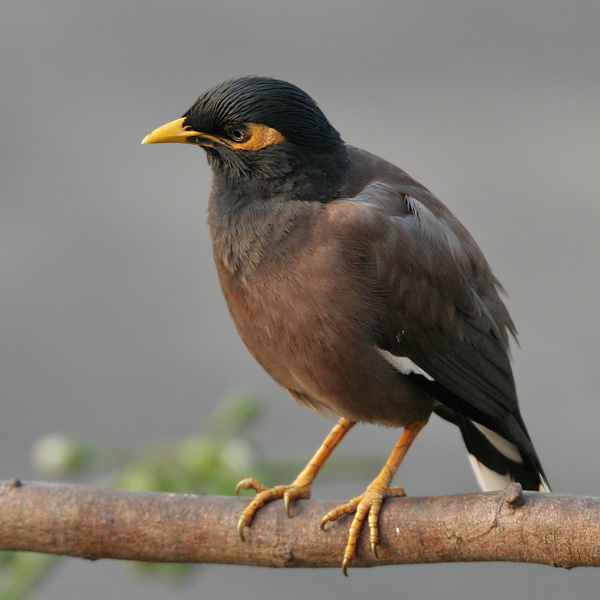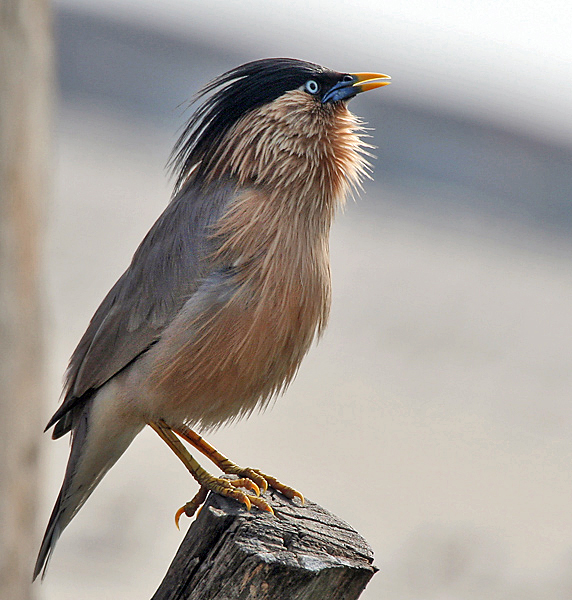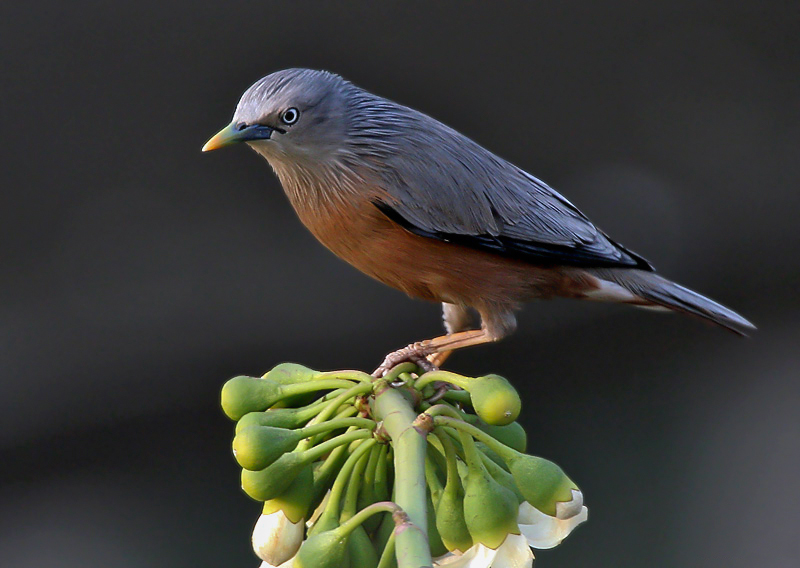 The Common Myna, Acridotheres tristis, is a less popular pet than the Hill Myna, Gracula religiosa, but is just as bright, and a very talented mimic. Unfortunately, admirers have released in many foreign habitats, where it causes a host of problems.
The Common Myna, Acridotheres tristis, is a less popular pet than the Hill Myna, Gracula religiosa, but is just as bright, and a very talented mimic. Unfortunately, admirers have released in many foreign habitats, where it causes a host of problems.
Mynas as Pets
The various Mynas are among the most sought after (and expensive) of all bird pets. These beautiful members of the starling family (Sturnidae) often amass vocabularies that rival those of any parrot, and are amazingly intelligent.
In addition to the Hill and Common Myna, aviculturists also favor the Pagoda Myna, Sturnus pagodarum, and the Malabar Myna, Sturnus malabaricus (please see photos). So it is sometimes surprising for bird fanciers to learn that at the Common Myna is on the “most wanted list” of many conservation organizations, including the IUCN (World Conservation Union).
Range
Clad in rust, black and yellow, the Common Myna’s huge natural range stretches from Iran and Kazakhstan through much of China to Malaysia. An aggressive colonizer that forms lifelong pair bonds, in some habitats it has actually replaced its relative, the European Starling, Sturnus vulgaris…not an easy task, considering that the entire US Starling population arose from a single group released in NYC’s Central Park!
 The Common Myna’s introduced range encompasses over 40 additional countries, including such far-flung locales as Russia, Australia, Fiji, South Africa, Hong Kong, the USA and Madagascar. The more delicate Hill Myna is established in Florida, California and Puerto Rico.
The Common Myna’s introduced range encompasses over 40 additional countries, including such far-flung locales as Russia, Australia, Fiji, South Africa, Hong Kong, the USA and Madagascar. The more delicate Hill Myna is established in Florida, California and Puerto Rico.
Beneficial, but…
Although it does consume harmful insect pests, the Common Myna’s “dark side” outshines this virtue. A hole nester, it out-competes parrots in Australia, with over 80% of the available nest sites being commandeered by Mynas in some habitats. Mynas also consume bird eggs and crops, and may spread avian diseases. They take well to people, and are the predominant species in some cities in eastern Australia.
Common Mynas on Hawaii
The story of the Common Myna’s “rise to power” on Hawaii is typical. Mynas were first brought to the islands in 1865 from India by Dr. W. Hildebrand. Dr. Hildebrand apparently had a penchant for moving animals about – along with the Mynas, he released Java Rice Birds, Chinese Quail, Golden Pheasants, deer and other creatures (and plants)!
The Common Mynas were supposed to battle Cutworm Moths, Spodoptera mauritia, which were devastating sugarcane fields. This they did, but they also developed a taste for the fruit of the Lantana plant, a troublesome exotic. By dispersing the Lantana’s seeds, Mynas helped it to quickly conquer new ground.
Soon hotel guests around Honolulu were complaining of the racket caused by roosting Mynas. At one hotel, caged cats were raised into roost trees to
“scare” the pests – a tactic that drew even more Mynas, who screamed at the unfortunate beasts for hours on end! By 1879, immense populations had built up in Honolulu, and all of Hawaii’s southeastern islands were colonized by the 1890’s. They seem not to have appeared on the northwestern islands until 1971.
 Dubbed Piakelo on Hawaii, Common Mynas have a somewhat mixed reputation…attractive plumage and a “swaggering” personality endears them to many. Commenting on a story that fires may have been started by Mynas carrying discarded cigarettes, one reporter stated, in 1900, “…even if the Myna is not an ideal bird, it is better than no bird at all”!
Dubbed Piakelo on Hawaii, Common Mynas have a somewhat mixed reputation…attractive plumage and a “swaggering” personality endears them to many. Commenting on a story that fires may have been started by Mynas carrying discarded cigarettes, one reporter stated, in 1900, “…even if the Myna is not an ideal bird, it is better than no bird at all”!
Further Reading
Common Myna ecology and invasions
Video: Myna trap
Myna and both Starling images referenced from wikipedia and originally posted by
J.M. Garg
 That Bird Blog – Bird Care and History for Pet Birds
That Bird Blog – Bird Care and History for Pet Birds



